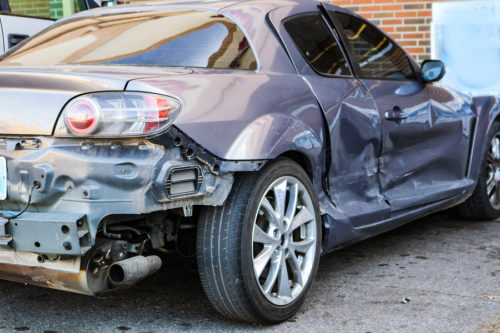Merging accidents in Kentucky and Tennessee can occur when drivers are changing lanes on a busy street, or when motorists are merging onto a highway. If a driver fails to use their turn signals or speeds up suddenly when approaching several lanes of traffic, this can cause an accident resulting in severe property damage and serious injuries.
Flora Templeton Stuart Accident Injury Lawyers has represented hundreds of clients seriously injured in car, truck, and motorcycle accidents when another vehicle drives into their lane.
What is a Car, Truck, or Motorcycle Sideswipe Accident?
A sideswipe accident is the result of two vehicles traveling in the same direction when the side of one car, truck, or motorcycle collides with the side of the other vehicle. Most sideswipe collisions occur because one vehicle leaves the lane it is traveling in and sideswipes the other vehicle while changing lanes. This is often referred to as unsafe lane changing.
In most cases, blame is apportioned to the driver of the vehicle leaving its lane of travel. The two most common types of sideswipe accidents happen when drivers are merging or changing lanes.
Determining Fault in Sideswipe Accidents
All vehicles are obliged to stay in their lane of travel, not leaving the lane unless safe to do so. While it might be easy to claim that the driver of the vehicle leaving its lane of travel and making an unsafe lane change is the at-fault party, it is not always straightforward to determine which driver left the lane of travel.
Many factors can help Flora Templeton Stuart Accident Injury Lawyers prove liability, including:
- Type of vehicle damage.
- Location of damage on vehicles.
- Resting position of vehicles after the accident.
Accounts from the car drivers and any witnesses to the accident will be instrumental in determining who is responsible for a merging accident in Glasgow. With accounts often conflicting, establishing liability can be challenging.
Liability When Changing Lanes in a Car Accident
In most cases, the driver of the vehicle changing lanes is at fault. The driver has a legal obligation to ensure it is safe to change lanes before maneuvering. This typically involves ensuring there is enough room to safely enter the other lane. Even if a motorist looks in their mirror, mirrors have blind spots. If a driver does not perform secondary checks – looking over their shoulder, for instance – this can constitute negligence. Drivers changing lanes without using a turn signal will typically be determined liable for a merging accident.
When Is the Driver Changing Lanes At Fault in a collision?
These are some of the most common scenarios in which the driver changing lanes is determined at fault for the merging accident:
- Neglecting to check blind spots before merging lanes.
- Failing to ensure there is enough space to switch lanes.
- Distractedly drifting into another lane.
- Speeding.
- Failing to use a turn signal before shifting lanes.
- Not turning on headlights at night.
- Driving too quickly for the road or weather conditions.
- Intentionally cutting off another vehicle due to road rage.
- Hydroplaning on slick roads.
- Cutting off the other car.
- Swerving between lanes because of driving under the influence of drink or drugs.
When Is the Driver Changing Lane in an accident in Kentucky or Tennessee Not At Fault?
Usually, the driver that does not merge lanes will not be determined completely at fault for the accident. That said, they may have some fault if they fail to fulfill their driving obligations by driving at a safe speed and paying attention to the movement of other vehicles. These are some of the most common scenarios in which the driver changing lanes is determined not at fault for the merging accident:
- A vehicle speeding up as you are changing lanes.
- A vehicle slowing down as you are changing lanes.
- The other motorist using a phone to talk or text.
- A driver willfully refusing to let your vehicle enter the intended lane of travel.
Liability When Merging on Kentucky & Tennessee Highways
When one lane is about to end and the car driver must enter another lane that is continuing to go forward, this is known as merging. In most cases, the driver merging during a collision is determined at fault because the other motorist has the right of way. The merger driver is obliged to yield the right of way. Failing to do so means they are at fault for any subsequent collision. The vehicle not merging can be determined partially at fault if they could have done something to avoid the accident.
When Is the Driver Merging At Fault in an Accident?
Some merging accidents occur frequently, with the follow scenarios involving the merging driver being determined liable for the accident:
- Merging onto the highway too quickly.
- Merging onto the highway too slowly.
- Cutting off another vehicle.
- Hesitating when merging.
- Neglecting to use a turn signal.
- Failing to check for vehicles in the lane before merging.
When Is the Non-Merging Driver Partially At Fault?
The non-merging driver has a duty to recognize when a lane is about to end, and also to anticipate the drivers from that lane are likely to merge into their lane. If the non-merging driver fails to exercise this duty, they can be determined partially at fault for the collision. These are some of the most common scenarios in which the driver not merging lanes is determined partially at fault for the merging accident:
- Deliberately speeding up so the merging driver is unable to enter the lane of travel.
- Failing to slow down.
- Neglecting to adjust speed to allow a merging driver to enter the lane of travel.
- Tailgating the vehicle preventing the merging driver from entering the lane.
Liability When A Vehicle is Changing Lanes
When both cars are changing lanes, both drivers likely have some fault for any subsequent accident. This often occurs when more than three lanes of travel are involved in one direction. For example, a car in the outside lane tries to move into the center lane, but at the same time a vehicle tries entering the center lane from the inside lane. Parts of each vehicle then collide as they attempt to enter one lane at the same time. In this example, neither driver has the right to enter the center lane, and both drivers have a duty to check that the center lane is clear before changing lanes.
These are some of the most common scenarios in which the driver fails to anticipate that a lane is clear before changing lanes:
- Trying to cross several lanes without pausing between lane changes.
- Not looking at cars two lanes across before entering the center lane.
- Not seeing a car with a turn signal on starting to change lanes.
- Switching between lanes in an attempt to get ahead of traffic.
How To Avoid a Merging Accident in Kentucky & Tennessee
When merging onto a highway in Glasgow, try to drive at the same speed as approaching vehicles. Always use your turn signal and avoid squeezing into tight gaps in traffic.
Call Flora Templeton Stuart Accident Injury Lawyers if you have been injured in an accident. At Flora Templeton Stuart, you get personal representation from top attorneys- no fee unless we recover for you.

